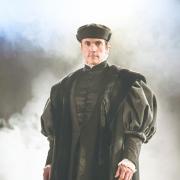In the latest of his profiles of Great Devonians, Ian L. Handford tells the tale of a man hampered by deafness, yet who remains a mathematician and scientist of world renown

Born in the slums of London on 13 May, 1850 Oliver Heaviside, a studious boy, contracted scarlet fever and was forever hampered by deafness. On leaving school at 16 and, able to understand both Morse code and languages, his first job was as a telegraph operator in Denmark.
Forever plagued by poor health, Oliver had to deal with deafness and bouts of jaundice throughout life. Maybe this was why he remained a reclusive bachelor. Nevertheless he became an exceptional scientist and visionary, his theories after being proved, making him one of the greatest mathematicians of the early 20th century.
In 1837 his uncle Charles Wheatstone, in conjunction with W.F. Cooke, had patented the “electrical network for measuring resistance” and by 1872 had invented the Wheatstone bridge. In publishing his first paper Comparing Electromotive Forces in 1871 Oliver had just returned from Denmark to work with the Great Northern Telegraph Company (GNT) dealing with overseas telephonic traffic.
In 1873 the second “Heaviside paper” attracted another scientist in the field, James Maxwell, who, like Wheatstone, had studied electricity and magnetism – to incorporate Oliver’s theories into his next edition of Treatise on Electricity and Magnetism, which drew another brilliant scientist and physicist George Fitzgerald to write: “Maxwell’s treatise is cumbered with debris of his brilliant lines of assault, of his entrenched camps, of his battles…(yet) Heaviside has cleared these away, and opened up a direct route…”
It would be Guglielmo Marconi who eventually tested Heaviside’s theories when in 1901 he successfully sent the first ever radio signals across the Atlantic to America. Marconi never understood how this could occur but Heaviside speculated wireless waves might cope with the curvature of the earth if they were “caught” by a something in the upper atmosphere. That theory was incorporated in the tenth edition of Encyclopaedia Britannica in 1902 and later it was confirmed, a layer of ionised particles in the upper atmosphere existed, although NOT proven until one year before Oliver’s death
Alternating current of electricity was commercially established 15 years before Heaviside established an ordinary symbolic method of alternating current circuits (AC) in 1892 which are still used today.
Having resigned from GNT, Heaviside continued his research and suggested that metallic circuits were guides, rather than conductors of AC current. Then, between 1880 and 1887 he developed an operational form of calculus, which is also used in pure mathematics today.
Next he suggested induction coils ought to be inserted into long distance telephone lines and applied telegraphy circuits, another success applied today. He even enhanced our knowledge of the relationship of the sun and earth as being a correlation of electromagnetism with gravitation.
Today his name is most associated with his earliest theory - radio waves and the earth’s curvature – due to his name being linked to the phenomenon “The Kennelly-Heaviside Layer”. This, a joint recognition, as Arthur Kennelly of Harvard had in America made a similar prediction.
The eminent mathematician Edmund Whittaker described Heaviside’s operational calculus as one of the three most important discoveries of the late 19th century and so it was not surprising that Heaviside was honoured as a Fellow of the Royal Society in 1891, and became the first recipient of the Faraday Medal from the Institution of Electrical Engineers.
In June 1889 Heaviside, together with his parents, came to live at Palace Avenue and after their death he moved to Newton Abbot and lived alone. His final move came after returning to live in Torquay to be nearer his brother. He spent 26 years in Devon and yet was always the odd man out at family reunions, being seen as unhappy and unsociable. Newton Abbot people however, often saw him out cycling while living a self-imposed, hermit-like existence.
In 1893 he published his first volume of research on electromagnetic theory before a second volume in 1899 and a third in 1912. His fourth volume would not be published until after his death.
Oliver Heaviside died from chronic prostatic enlargement. Having been found unconscious at his home, Highfield in Lower Warberry Road, Torquay, our scientific genius later died in a local nursing home on 3 February, 1925, age 74. The family grave in Colley End Road Cemetery Paignton, has become a place of pilgrimage for those honouring a scientist with craters on the Moon and Mars named after him.
Next month: the apothecary from Kingsbridge who discovered how the Chinese made fine porcelain and soon Britain would supply the world with china clay.
This article was first published in the March issue of Devon Life. To get the magazine delivered every month to your home, subscribe at www.subscriptionsave.co.uk/dev or call 08448484217



























